Detailed Finance and Operations Report: New Life Training PLC
VerifiedAdded on 2020/10/22
|11
|3206
|66
Report
AI Summary
This report provides a comprehensive analysis of the financial and operational aspects of New Life Training PLC. It begins with an evaluation of operational and regulatory factors considered by the board, including the company's vision to be listed on the London Stock Exchange. The report then estimates income and expenditure projections for the first four years, detailing expected revenues from franchise training, student sessions, and private hire. A critical evaluation of the financial worth of the current proposal is presented, including contribution analysis, break-even analysis, payback period, and average rate of return. The report provides a detailed financial analysis, including income statements, and concludes with recommendations for the board based on the financial projections and evaluations. The report assesses the financial stability and provides insights into the company's strategic financial planning, capital structure, and investment appraisal methods.
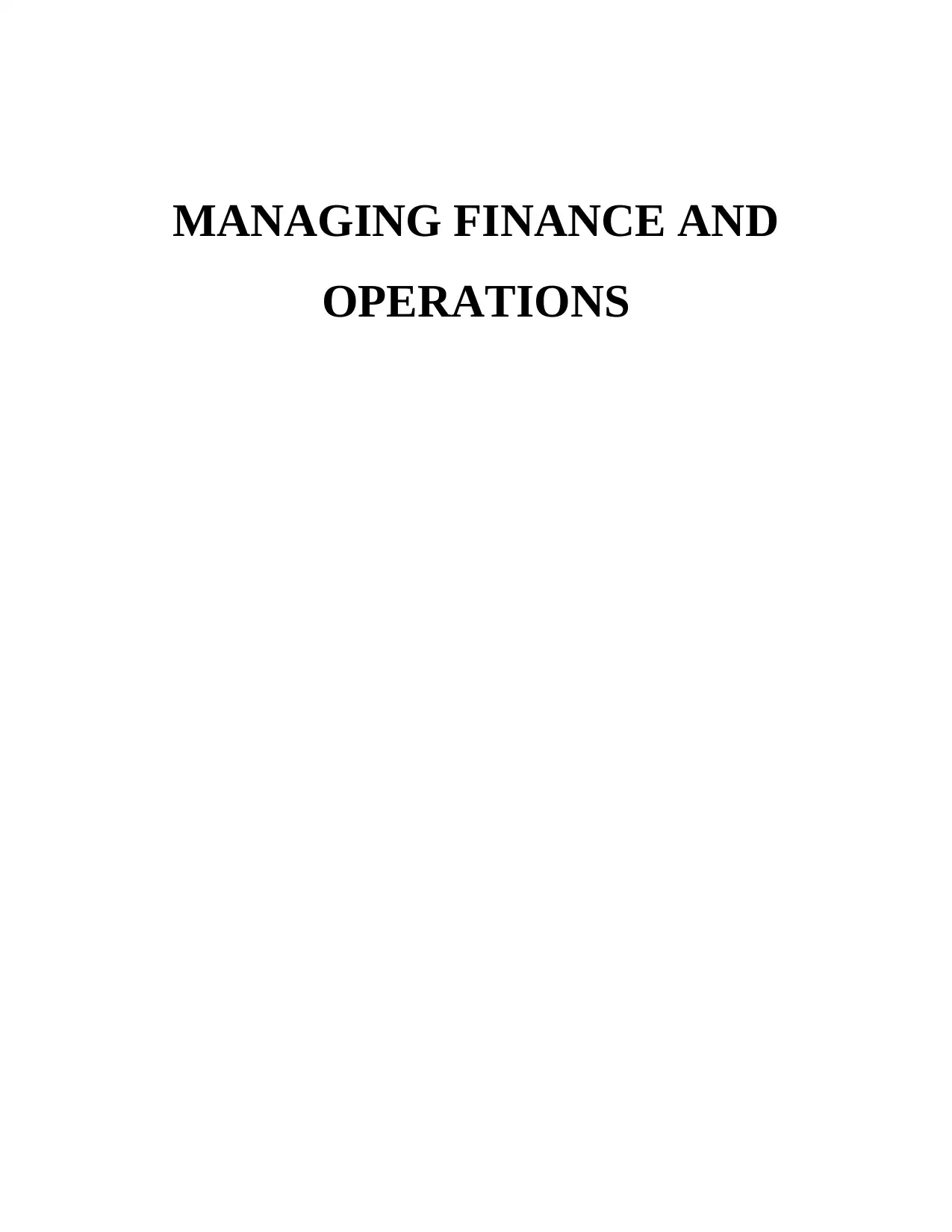
MANAGING FINANCE AND
OPERATIONS
OPERATIONS
Paraphrase This Document
Need a fresh take? Get an instant paraphrase of this document with our AI Paraphraser
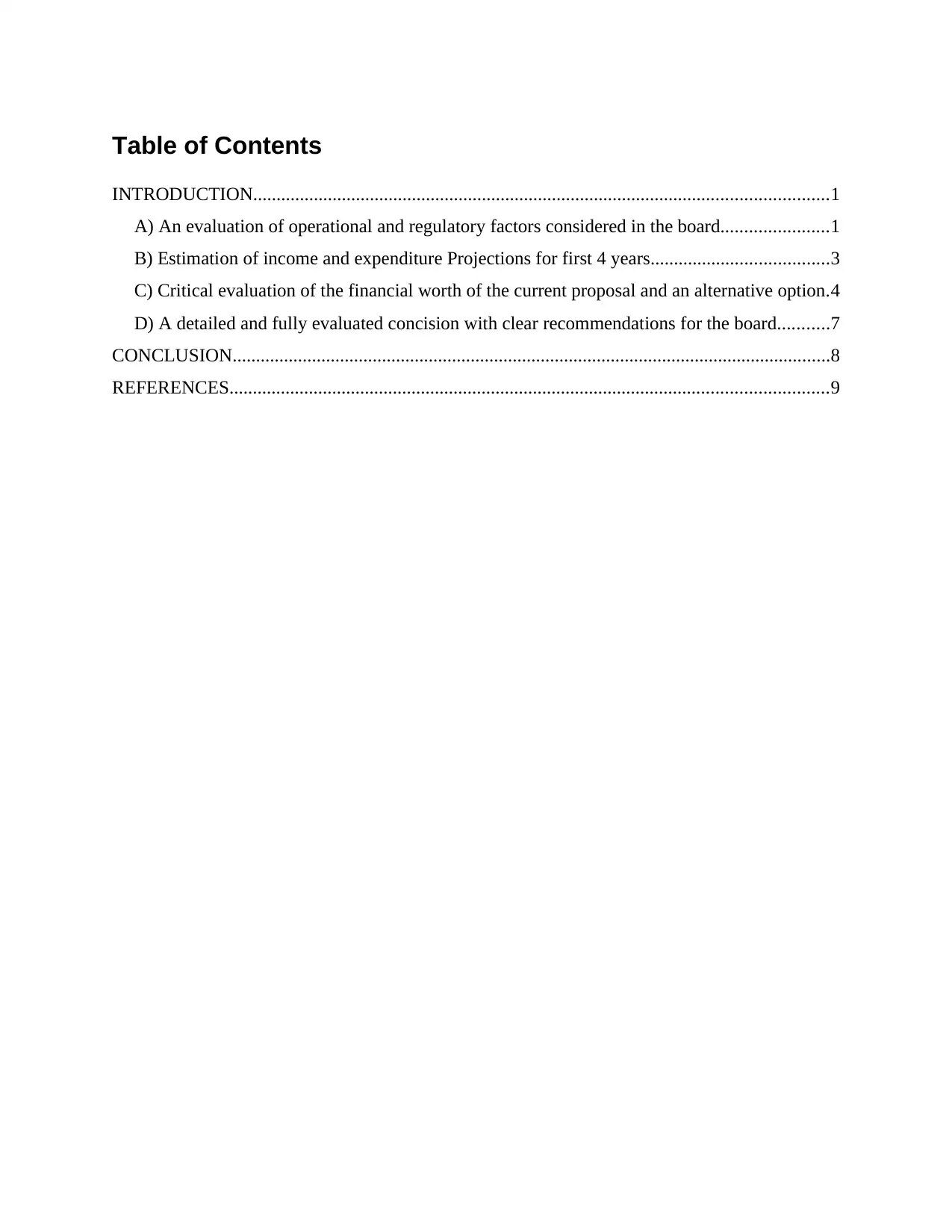
Table of Contents
INTRODUCTION...........................................................................................................................1
A) An evaluation of operational and regulatory factors considered in the board.......................1
B) Estimation of income and expenditure Projections for first 4 years......................................3
C) Critical evaluation of the financial worth of the current proposal and an alternative option.4
D) A detailed and fully evaluated concision with clear recommendations for the board...........7
CONCLUSION................................................................................................................................8
REFERENCES................................................................................................................................9
INTRODUCTION...........................................................................................................................1
A) An evaluation of operational and regulatory factors considered in the board.......................1
B) Estimation of income and expenditure Projections for first 4 years......................................3
C) Critical evaluation of the financial worth of the current proposal and an alternative option.4
D) A detailed and fully evaluated concision with clear recommendations for the board...........7
CONCLUSION................................................................................................................................8
REFERENCES................................................................................................................................9
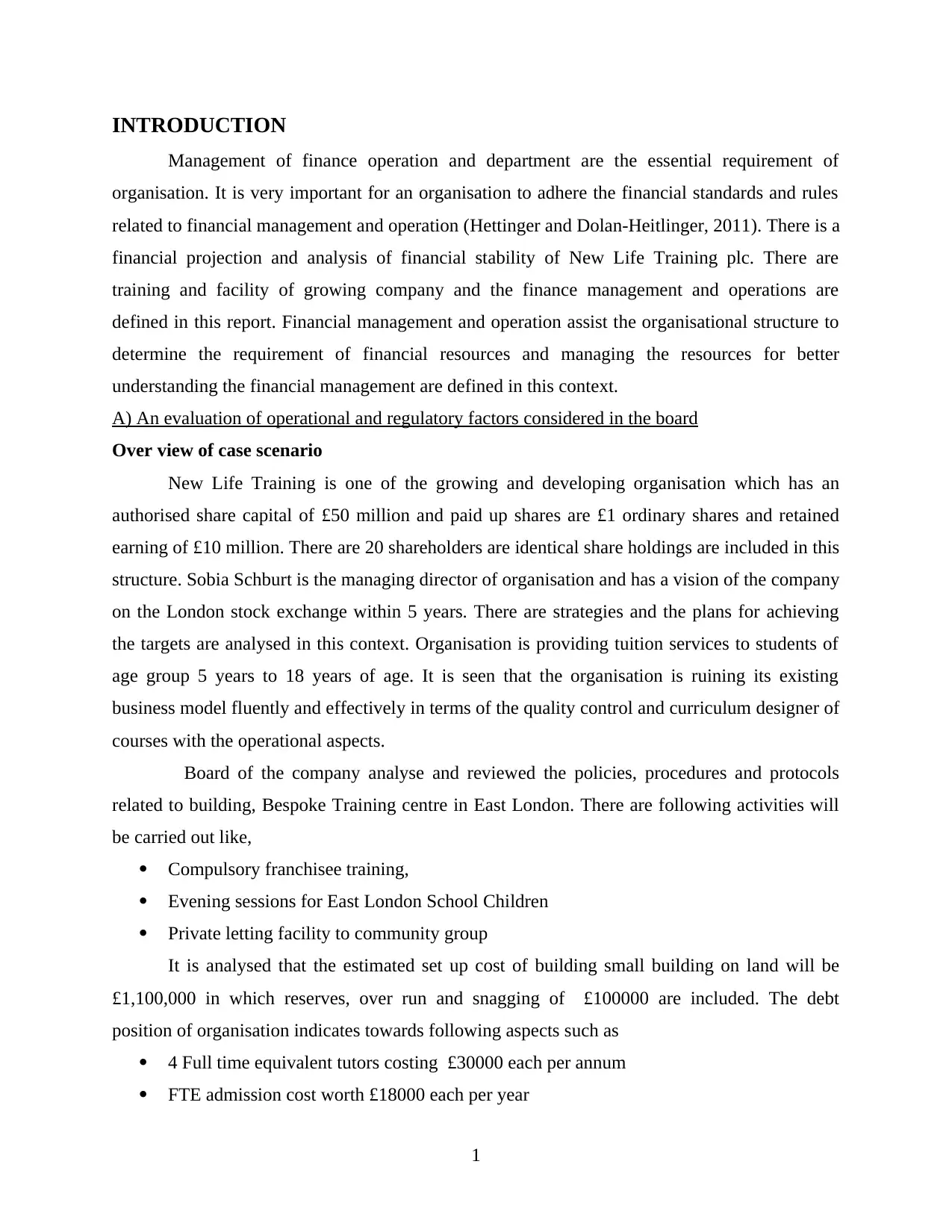
INTRODUCTION
Management of finance operation and department are the essential requirement of
organisation. It is very important for an organisation to adhere the financial standards and rules
related to financial management and operation (Hettinger and Dolan-Heitlinger, 2011). There is a
financial projection and analysis of financial stability of New Life Training plc. There are
training and facility of growing company and the finance management and operations are
defined in this report. Financial management and operation assist the organisational structure to
determine the requirement of financial resources and managing the resources for better
understanding the financial management are defined in this context.
A) An evaluation of operational and regulatory factors considered in the board
Over view of case scenario
New Life Training is one of the growing and developing organisation which has an
authorised share capital of £50 million and paid up shares are £1 ordinary shares and retained
earning of £10 million. There are 20 shareholders are identical share holdings are included in this
structure. Sobia Schburt is the managing director of organisation and has a vision of the company
on the London stock exchange within 5 years. There are strategies and the plans for achieving
the targets are analysed in this context. Organisation is providing tuition services to students of
age group 5 years to 18 years of age. It is seen that the organisation is ruining its existing
business model fluently and effectively in terms of the quality control and curriculum designer of
courses with the operational aspects.
Board of the company analyse and reviewed the policies, procedures and protocols
related to building, Bespoke Training centre in East London. There are following activities will
be carried out like,
Compulsory franchisee training,
Evening sessions for East London School Children
Private letting facility to community group
It is analysed that the estimated set up cost of building small building on land will be
£1,100,000 in which reserves, over run and snagging of £100000 are included. The debt
position of organisation indicates towards following aspects such as
4 Full time equivalent tutors costing £30000 each per annum
FTE admission cost worth £18000 each per year
1
Management of finance operation and department are the essential requirement of
organisation. It is very important for an organisation to adhere the financial standards and rules
related to financial management and operation (Hettinger and Dolan-Heitlinger, 2011). There is a
financial projection and analysis of financial stability of New Life Training plc. There are
training and facility of growing company and the finance management and operations are
defined in this report. Financial management and operation assist the organisational structure to
determine the requirement of financial resources and managing the resources for better
understanding the financial management are defined in this context.
A) An evaluation of operational and regulatory factors considered in the board
Over view of case scenario
New Life Training is one of the growing and developing organisation which has an
authorised share capital of £50 million and paid up shares are £1 ordinary shares and retained
earning of £10 million. There are 20 shareholders are identical share holdings are included in this
structure. Sobia Schburt is the managing director of organisation and has a vision of the company
on the London stock exchange within 5 years. There are strategies and the plans for achieving
the targets are analysed in this context. Organisation is providing tuition services to students of
age group 5 years to 18 years of age. It is seen that the organisation is ruining its existing
business model fluently and effectively in terms of the quality control and curriculum designer of
courses with the operational aspects.
Board of the company analyse and reviewed the policies, procedures and protocols
related to building, Bespoke Training centre in East London. There are following activities will
be carried out like,
Compulsory franchisee training,
Evening sessions for East London School Children
Private letting facility to community group
It is analysed that the estimated set up cost of building small building on land will be
£1,100,000 in which reserves, over run and snagging of £100000 are included. The debt
position of organisation indicates towards following aspects such as
4 Full time equivalent tutors costing £30000 each per annum
FTE admission cost worth £18000 each per year
1
⊘ This is a preview!⊘
Do you want full access?
Subscribe today to unlock all pages.

Trusted by 1+ million students worldwide
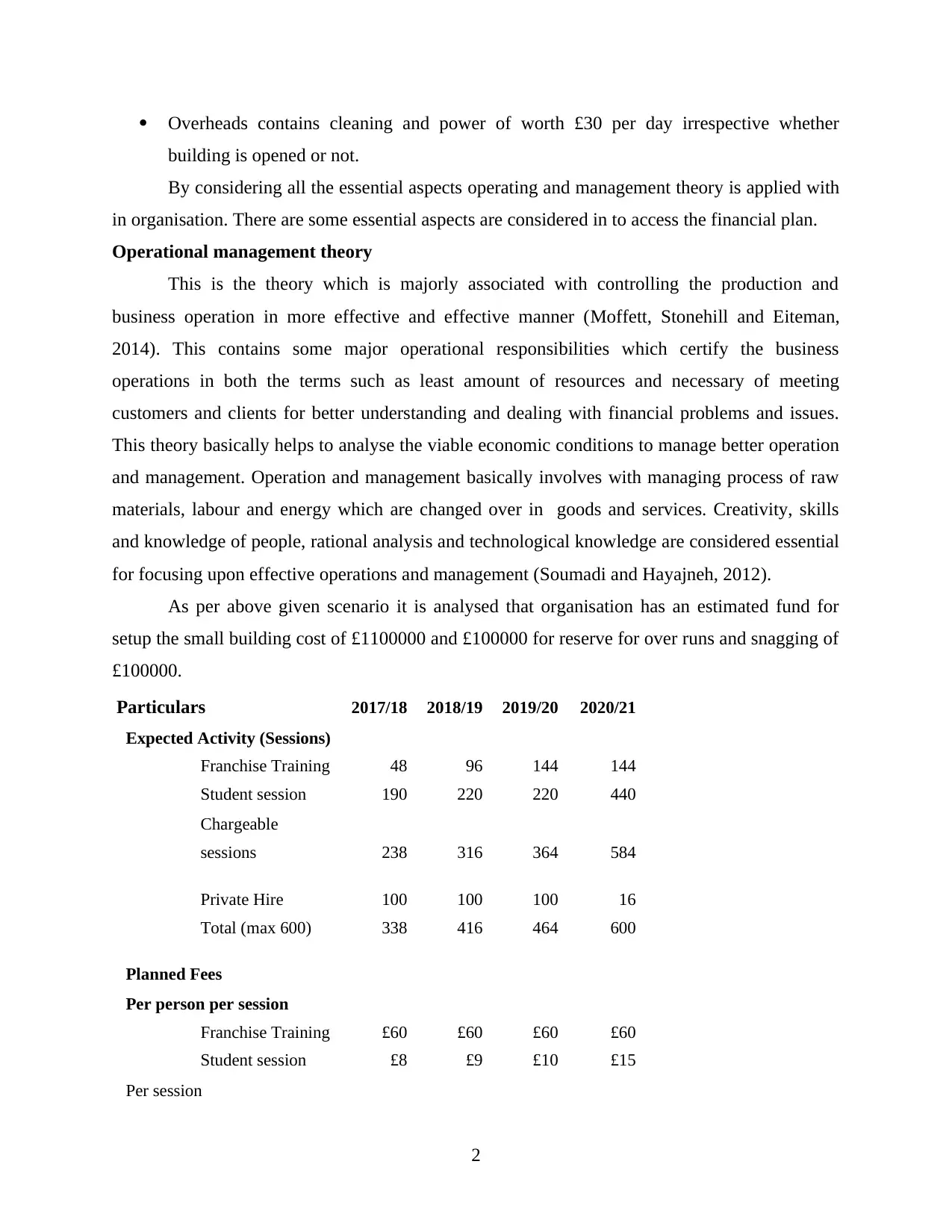
Overheads contains cleaning and power of worth £30 per day irrespective whether
building is opened or not.
By considering all the essential aspects operating and management theory is applied with
in organisation. There are some essential aspects are considered in to access the financial plan.
Operational management theory
This is the theory which is majorly associated with controlling the production and
business operation in more effective and effective manner (Moffett, Stonehill and Eiteman,
2014). This contains some major operational responsibilities which certify the business
operations in both the terms such as least amount of resources and necessary of meeting
customers and clients for better understanding and dealing with financial problems and issues.
This theory basically helps to analyse the viable economic conditions to manage better operation
and management. Operation and management basically involves with managing process of raw
materials, labour and energy which are changed over in goods and services. Creativity, skills
and knowledge of people, rational analysis and technological knowledge are considered essential
for focusing upon effective operations and management (Soumadi and Hayajneh, 2012).
As per above given scenario it is analysed that organisation has an estimated fund for
setup the small building cost of £1100000 and £100000 for reserve for over runs and snagging of
£100000.
Particulars 2017/18 2018/19 2019/20 2020/21
Expected Activity (Sessions)
Franchise Training 48 96 144 144
Student session 190 220 220 440
Chargeable
sessions 238 316 364 584
Private Hire 100 100 100 16
Total (max 600) 338 416 464 600
Planned Fees
Per person per session
Franchise Training £60 £60 £60 £60
Student session £8 £9 £10 £15
Per session
2
building is opened or not.
By considering all the essential aspects operating and management theory is applied with
in organisation. There are some essential aspects are considered in to access the financial plan.
Operational management theory
This is the theory which is majorly associated with controlling the production and
business operation in more effective and effective manner (Moffett, Stonehill and Eiteman,
2014). This contains some major operational responsibilities which certify the business
operations in both the terms such as least amount of resources and necessary of meeting
customers and clients for better understanding and dealing with financial problems and issues.
This theory basically helps to analyse the viable economic conditions to manage better operation
and management. Operation and management basically involves with managing process of raw
materials, labour and energy which are changed over in goods and services. Creativity, skills
and knowledge of people, rational analysis and technological knowledge are considered essential
for focusing upon effective operations and management (Soumadi and Hayajneh, 2012).
As per above given scenario it is analysed that organisation has an estimated fund for
setup the small building cost of £1100000 and £100000 for reserve for over runs and snagging of
£100000.
Particulars 2017/18 2018/19 2019/20 2020/21
Expected Activity (Sessions)
Franchise Training 48 96 144 144
Student session 190 220 220 440
Chargeable
sessions 238 316 364 584
Private Hire 100 100 100 16
Total (max 600) 338 416 464 600
Planned Fees
Per person per session
Franchise Training £60 £60 £60 £60
Student session £8 £9 £10 £15
Per session
2
Paraphrase This Document
Need a fresh take? Get an instant paraphrase of this document with our AI Paraphraser
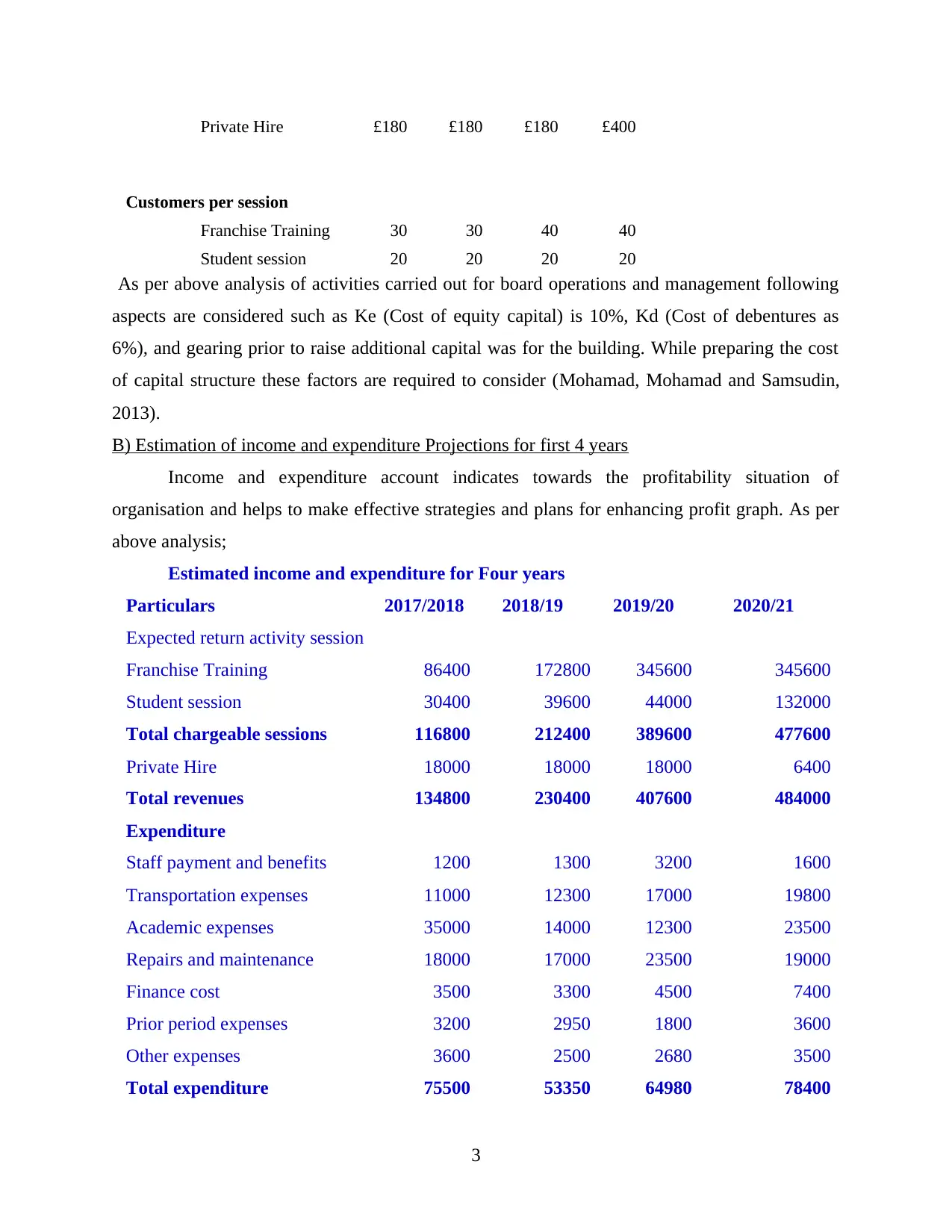
Private Hire £180 £180 £180 £400
Customers per session
Franchise Training 30 30 40 40
Student session 20 20 20 20
As per above analysis of activities carried out for board operations and management following
aspects are considered such as Ke (Cost of equity capital) is 10%, Kd (Cost of debentures as
6%), and gearing prior to raise additional capital was for the building. While preparing the cost
of capital structure these factors are required to consider (Mohamad, Mohamad and Samsudin,
2013).
B) Estimation of income and expenditure Projections for first 4 years
Income and expenditure account indicates towards the profitability situation of
organisation and helps to make effective strategies and plans for enhancing profit graph. As per
above analysis;
Estimated income and expenditure for Four years
Particulars 2017/2018 2018/19 2019/20 2020/21
Expected return activity session
Franchise Training 86400 172800 345600 345600
Student session 30400 39600 44000 132000
Total chargeable sessions 116800 212400 389600 477600
Private Hire 18000 18000 18000 6400
Total revenues 134800 230400 407600 484000
Expenditure
Staff payment and benefits 1200 1300 3200 1600
Transportation expenses 11000 12300 17000 19800
Academic expenses 35000 14000 12300 23500
Repairs and maintenance 18000 17000 23500 19000
Finance cost 3500 3300 4500 7400
Prior period expenses 3200 2950 1800 3600
Other expenses 3600 2500 2680 3500
Total expenditure 75500 53350 64980 78400
3
Customers per session
Franchise Training 30 30 40 40
Student session 20 20 20 20
As per above analysis of activities carried out for board operations and management following
aspects are considered such as Ke (Cost of equity capital) is 10%, Kd (Cost of debentures as
6%), and gearing prior to raise additional capital was for the building. While preparing the cost
of capital structure these factors are required to consider (Mohamad, Mohamad and Samsudin,
2013).
B) Estimation of income and expenditure Projections for first 4 years
Income and expenditure account indicates towards the profitability situation of
organisation and helps to make effective strategies and plans for enhancing profit graph. As per
above analysis;
Estimated income and expenditure for Four years
Particulars 2017/2018 2018/19 2019/20 2020/21
Expected return activity session
Franchise Training 86400 172800 345600 345600
Student session 30400 39600 44000 132000
Total chargeable sessions 116800 212400 389600 477600
Private Hire 18000 18000 18000 6400
Total revenues 134800 230400 407600 484000
Expenditure
Staff payment and benefits 1200 1300 3200 1600
Transportation expenses 11000 12300 17000 19800
Academic expenses 35000 14000 12300 23500
Repairs and maintenance 18000 17000 23500 19000
Finance cost 3500 3300 4500 7400
Prior period expenses 3200 2950 1800 3600
Other expenses 3600 2500 2680 3500
Total expenditure 75500 53350 64980 78400
3
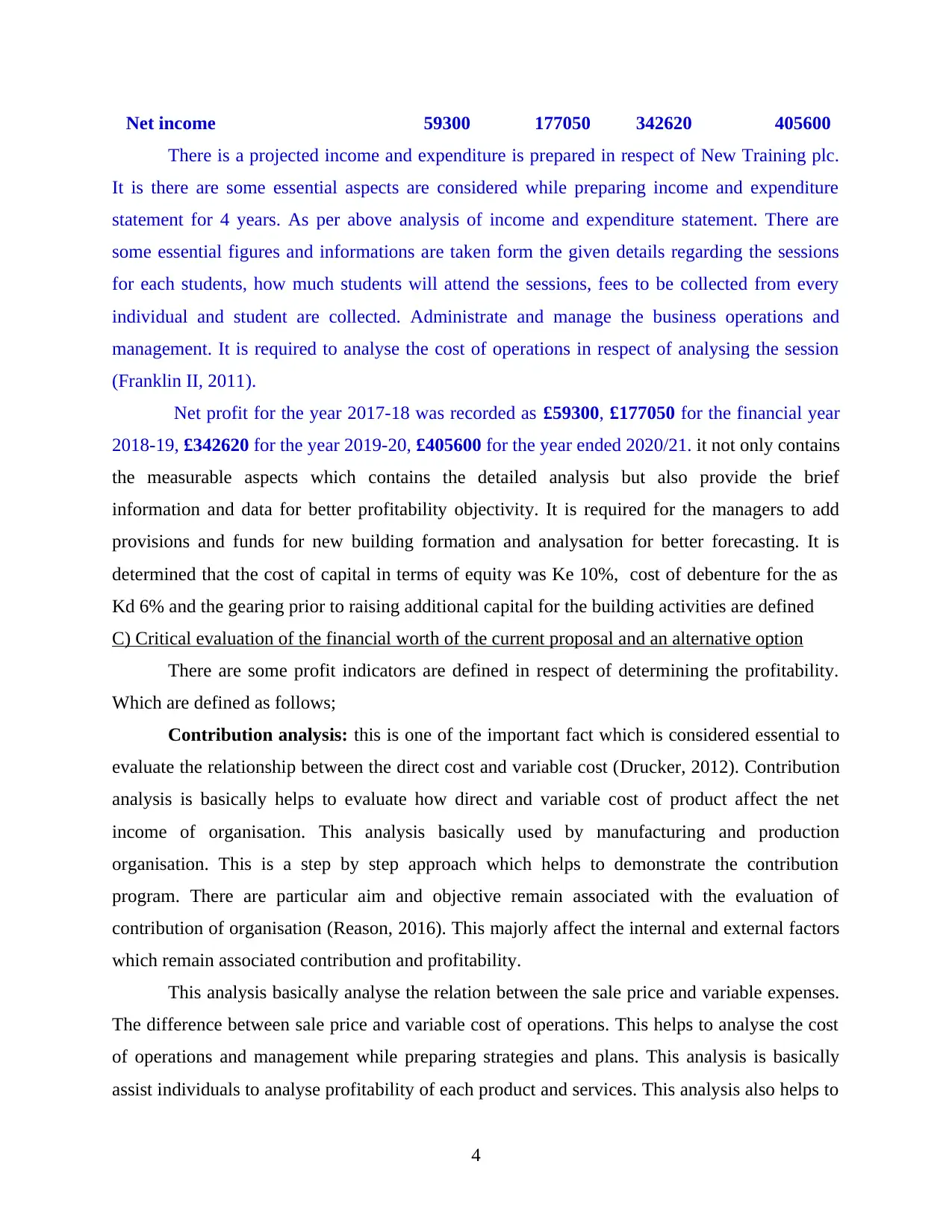
Net income 59300 177050 342620 405600
There is a projected income and expenditure is prepared in respect of New Training plc.
It is there are some essential aspects are considered while preparing income and expenditure
statement for 4 years. As per above analysis of income and expenditure statement. There are
some essential figures and informations are taken form the given details regarding the sessions
for each students, how much students will attend the sessions, fees to be collected from every
individual and student are collected. Administrate and manage the business operations and
management. It is required to analyse the cost of operations in respect of analysing the session
(Franklin II, 2011).
Net profit for the year 2017-18 was recorded as £59300, £177050 for the financial year
2018-19, £342620 for the year 2019-20, £405600 for the year ended 2020/21. it not only contains
the measurable aspects which contains the detailed analysis but also provide the brief
information and data for better profitability objectivity. It is required for the managers to add
provisions and funds for new building formation and analysation for better forecasting. It is
determined that the cost of capital in terms of equity was Ke 10%, cost of debenture for the as
Kd 6% and the gearing prior to raising additional capital for the building activities are defined
C) Critical evaluation of the financial worth of the current proposal and an alternative option
There are some profit indicators are defined in respect of determining the profitability.
Which are defined as follows;
Contribution analysis: this is one of the important fact which is considered essential to
evaluate the relationship between the direct cost and variable cost (Drucker, 2012). Contribution
analysis is basically helps to evaluate how direct and variable cost of product affect the net
income of organisation. This analysis basically used by manufacturing and production
organisation. This is a step by step approach which helps to demonstrate the contribution
program. There are particular aim and objective remain associated with the evaluation of
contribution of organisation (Reason, 2016). This majorly affect the internal and external factors
which remain associated contribution and profitability.
This analysis basically analyse the relation between the sale price and variable expenses.
The difference between sale price and variable cost of operations. This helps to analyse the cost
of operations and management while preparing strategies and plans. This analysis is basically
assist individuals to analyse profitability of each product and services. This analysis also helps to
4
There is a projected income and expenditure is prepared in respect of New Training plc.
It is there are some essential aspects are considered while preparing income and expenditure
statement for 4 years. As per above analysis of income and expenditure statement. There are
some essential figures and informations are taken form the given details regarding the sessions
for each students, how much students will attend the sessions, fees to be collected from every
individual and student are collected. Administrate and manage the business operations and
management. It is required to analyse the cost of operations in respect of analysing the session
(Franklin II, 2011).
Net profit for the year 2017-18 was recorded as £59300, £177050 for the financial year
2018-19, £342620 for the year 2019-20, £405600 for the year ended 2020/21. it not only contains
the measurable aspects which contains the detailed analysis but also provide the brief
information and data for better profitability objectivity. It is required for the managers to add
provisions and funds for new building formation and analysation for better forecasting. It is
determined that the cost of capital in terms of equity was Ke 10%, cost of debenture for the as
Kd 6% and the gearing prior to raising additional capital for the building activities are defined
C) Critical evaluation of the financial worth of the current proposal and an alternative option
There are some profit indicators are defined in respect of determining the profitability.
Which are defined as follows;
Contribution analysis: this is one of the important fact which is considered essential to
evaluate the relationship between the direct cost and variable cost (Drucker, 2012). Contribution
analysis is basically helps to evaluate how direct and variable cost of product affect the net
income of organisation. This analysis basically used by manufacturing and production
organisation. This is a step by step approach which helps to demonstrate the contribution
program. There are particular aim and objective remain associated with the evaluation of
contribution of organisation (Reason, 2016). This majorly affect the internal and external factors
which remain associated contribution and profitability.
This analysis basically analyse the relation between the sale price and variable expenses.
The difference between sale price and variable cost of operations. This helps to analyse the cost
of operations and management while preparing strategies and plans. This analysis is basically
assist individuals to analyse profitability of each product and services. This analysis also helps to
4
⊘ This is a preview!⊘
Do you want full access?
Subscribe today to unlock all pages.

Trusted by 1+ million students worldwide
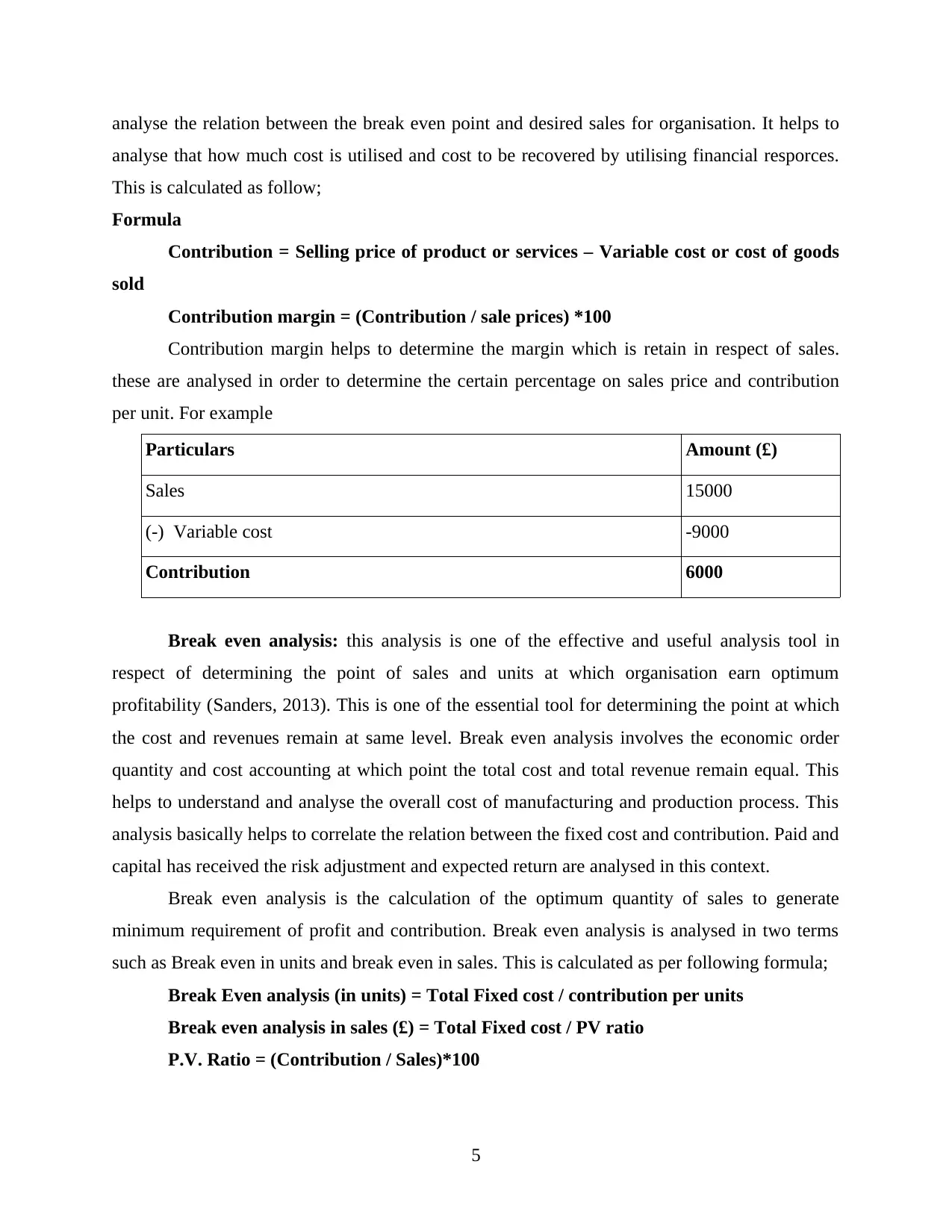
analyse the relation between the break even point and desired sales for organisation. It helps to
analyse that how much cost is utilised and cost to be recovered by utilising financial resporces.
This is calculated as follow;
Formula
Contribution = Selling price of product or services – Variable cost or cost of goods
sold
Contribution margin = (Contribution / sale prices) *100
Contribution margin helps to determine the margin which is retain in respect of sales.
these are analysed in order to determine the certain percentage on sales price and contribution
per unit. For example
Particulars Amount (£)
Sales 15000
(-) Variable cost -9000
Contribution 6000
Break even analysis: this analysis is one of the effective and useful analysis tool in
respect of determining the point of sales and units at which organisation earn optimum
profitability (Sanders, 2013). This is one of the essential tool for determining the point at which
the cost and revenues remain at same level. Break even analysis involves the economic order
quantity and cost accounting at which point the total cost and total revenue remain equal. This
helps to understand and analyse the overall cost of manufacturing and production process. This
analysis basically helps to correlate the relation between the fixed cost and contribution. Paid and
capital has received the risk adjustment and expected return are analysed in this context.
Break even analysis is the calculation of the optimum quantity of sales to generate
minimum requirement of profit and contribution. Break even analysis is analysed in two terms
such as Break even in units and break even in sales. This is calculated as per following formula;
Break Even analysis (in units) = Total Fixed cost / contribution per units
Break even analysis in sales (£) = Total Fixed cost / PV ratio
P.V. Ratio = (Contribution / Sales)*100
5
analyse that how much cost is utilised and cost to be recovered by utilising financial resporces.
This is calculated as follow;
Formula
Contribution = Selling price of product or services – Variable cost or cost of goods
sold
Contribution margin = (Contribution / sale prices) *100
Contribution margin helps to determine the margin which is retain in respect of sales.
these are analysed in order to determine the certain percentage on sales price and contribution
per unit. For example
Particulars Amount (£)
Sales 15000
(-) Variable cost -9000
Contribution 6000
Break even analysis: this analysis is one of the effective and useful analysis tool in
respect of determining the point of sales and units at which organisation earn optimum
profitability (Sanders, 2013). This is one of the essential tool for determining the point at which
the cost and revenues remain at same level. Break even analysis involves the economic order
quantity and cost accounting at which point the total cost and total revenue remain equal. This
helps to understand and analyse the overall cost of manufacturing and production process. This
analysis basically helps to correlate the relation between the fixed cost and contribution. Paid and
capital has received the risk adjustment and expected return are analysed in this context.
Break even analysis is the calculation of the optimum quantity of sales to generate
minimum requirement of profit and contribution. Break even analysis is analysed in two terms
such as Break even in units and break even in sales. This is calculated as per following formula;
Break Even analysis (in units) = Total Fixed cost / contribution per units
Break even analysis in sales (£) = Total Fixed cost / PV ratio
P.V. Ratio = (Contribution / Sales)*100
5
Paraphrase This Document
Need a fresh take? Get an instant paraphrase of this document with our AI Paraphraser
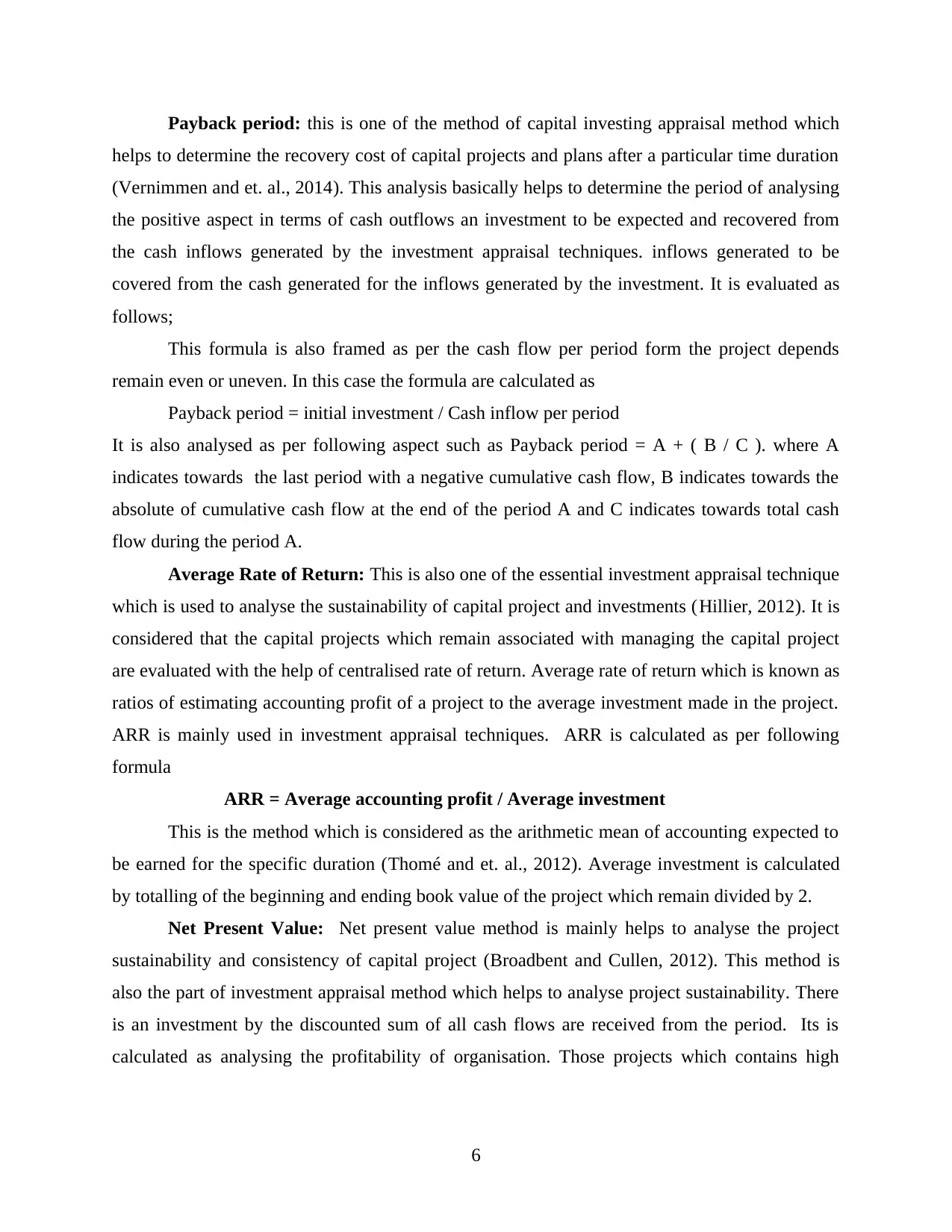
Payback period: this is one of the method of capital investing appraisal method which
helps to determine the recovery cost of capital projects and plans after a particular time duration
(Vernimmen and et. al., 2014). This analysis basically helps to determine the period of analysing
the positive aspect in terms of cash outflows an investment to be expected and recovered from
the cash inflows generated by the investment appraisal techniques. inflows generated to be
covered from the cash generated for the inflows generated by the investment. It is evaluated as
follows;
This formula is also framed as per the cash flow per period form the project depends
remain even or uneven. In this case the formula are calculated as
Payback period = initial investment / Cash inflow per period
It is also analysed as per following aspect such as Payback period = A + ( B / C ). where A
indicates towards the last period with a negative cumulative cash flow, B indicates towards the
absolute of cumulative cash flow at the end of the period A and C indicates towards total cash
flow during the period A.
Average Rate of Return: This is also one of the essential investment appraisal technique
which is used to analyse the sustainability of capital project and investments (Hillier, 2012). It is
considered that the capital projects which remain associated with managing the capital project
are evaluated with the help of centralised rate of return. Average rate of return which is known as
ratios of estimating accounting profit of a project to the average investment made in the project.
ARR is mainly used in investment appraisal techniques. ARR is calculated as per following
formula
ARR = Average accounting profit / Average investment
This is the method which is considered as the arithmetic mean of accounting expected to
be earned for the specific duration (Thomé and et. al., 2012). Average investment is calculated
by totalling of the beginning and ending book value of the project which remain divided by 2.
Net Present Value: Net present value method is mainly helps to analyse the project
sustainability and consistency of capital project (Broadbent and Cullen, 2012). This method is
also the part of investment appraisal method which helps to analyse project sustainability. There
is an investment by the discounted sum of all cash flows are received from the period. Its is
calculated as analysing the profitability of organisation. Those projects which contains high
6
helps to determine the recovery cost of capital projects and plans after a particular time duration
(Vernimmen and et. al., 2014). This analysis basically helps to determine the period of analysing
the positive aspect in terms of cash outflows an investment to be expected and recovered from
the cash inflows generated by the investment appraisal techniques. inflows generated to be
covered from the cash generated for the inflows generated by the investment. It is evaluated as
follows;
This formula is also framed as per the cash flow per period form the project depends
remain even or uneven. In this case the formula are calculated as
Payback period = initial investment / Cash inflow per period
It is also analysed as per following aspect such as Payback period = A + ( B / C ). where A
indicates towards the last period with a negative cumulative cash flow, B indicates towards the
absolute of cumulative cash flow at the end of the period A and C indicates towards total cash
flow during the period A.
Average Rate of Return: This is also one of the essential investment appraisal technique
which is used to analyse the sustainability of capital project and investments (Hillier, 2012). It is
considered that the capital projects which remain associated with managing the capital project
are evaluated with the help of centralised rate of return. Average rate of return which is known as
ratios of estimating accounting profit of a project to the average investment made in the project.
ARR is mainly used in investment appraisal techniques. ARR is calculated as per following
formula
ARR = Average accounting profit / Average investment
This is the method which is considered as the arithmetic mean of accounting expected to
be earned for the specific duration (Thomé and et. al., 2012). Average investment is calculated
by totalling of the beginning and ending book value of the project which remain divided by 2.
Net Present Value: Net present value method is mainly helps to analyse the project
sustainability and consistency of capital project (Broadbent and Cullen, 2012). This method is
also the part of investment appraisal method which helps to analyse project sustainability. There
is an investment by the discounted sum of all cash flows are received from the period. Its is
calculated as analysing the profitability of organisation. Those projects which contains high
6
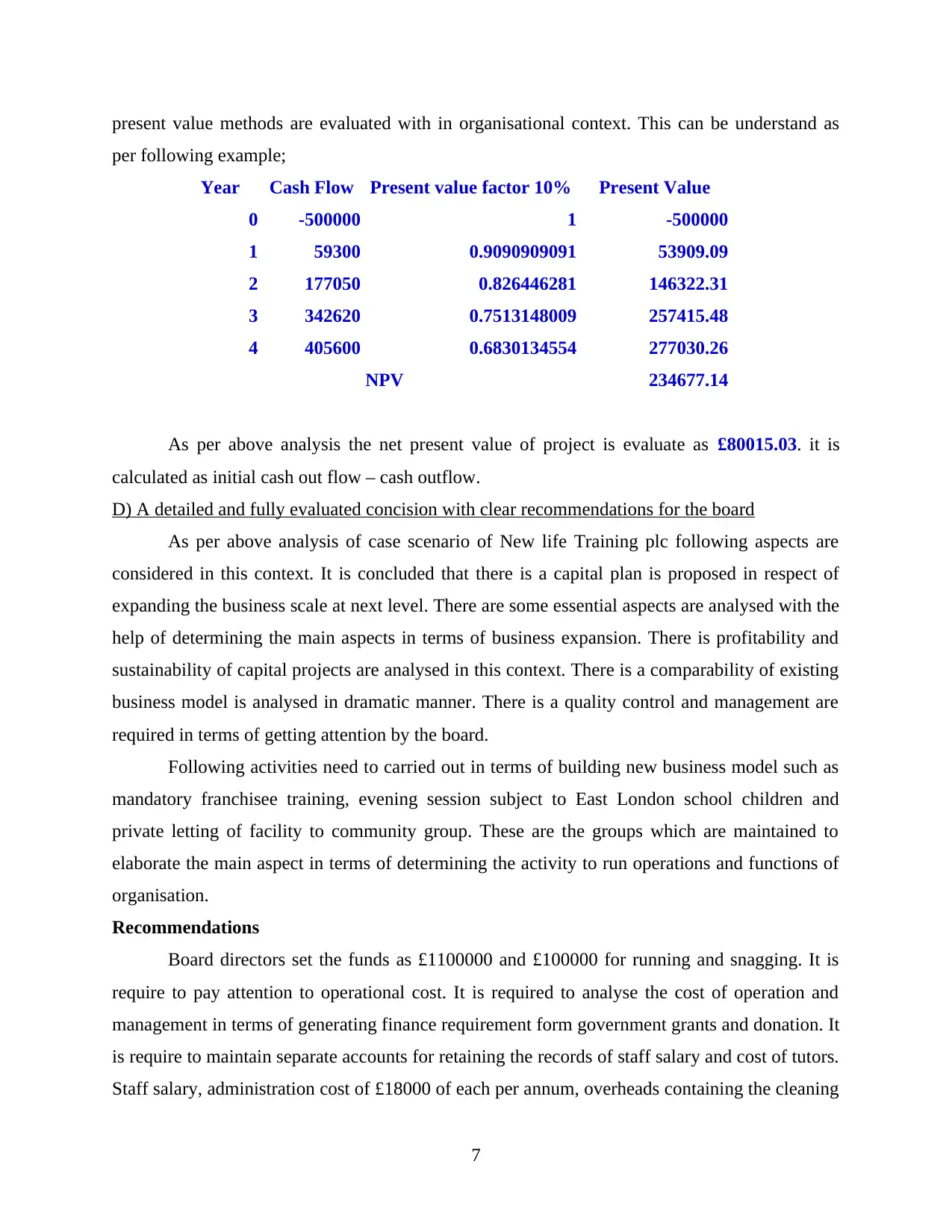
present value methods are evaluated with in organisational context. This can be understand as
per following example;
Year Cash Flow Present value factor 10% Present Value
0 -500000 1 -500000
1 59300 0.9090909091 53909.09
2 177050 0.826446281 146322.31
3 342620 0.7513148009 257415.48
4 405600 0.6830134554 277030.26
NPV 234677.14
As per above analysis the net present value of project is evaluate as £80015.03. it is
calculated as initial cash out flow – cash outflow.
D) A detailed and fully evaluated concision with clear recommendations for the board
As per above analysis of case scenario of New life Training plc following aspects are
considered in this context. It is concluded that there is a capital plan is proposed in respect of
expanding the business scale at next level. There are some essential aspects are analysed with the
help of determining the main aspects in terms of business expansion. There is profitability and
sustainability of capital projects are analysed in this context. There is a comparability of existing
business model is analysed in dramatic manner. There is a quality control and management are
required in terms of getting attention by the board.
Following activities need to carried out in terms of building new business model such as
mandatory franchisee training, evening session subject to East London school children and
private letting of facility to community group. These are the groups which are maintained to
elaborate the main aspect in terms of determining the activity to run operations and functions of
organisation.
Recommendations
Board directors set the funds as £1100000 and £100000 for running and snagging. It is
require to pay attention to operational cost. It is required to analyse the cost of operation and
management in terms of generating finance requirement form government grants and donation. It
is require to maintain separate accounts for retaining the records of staff salary and cost of tutors.
Staff salary, administration cost of £18000 of each per annum, overheads containing the cleaning
7
per following example;
Year Cash Flow Present value factor 10% Present Value
0 -500000 1 -500000
1 59300 0.9090909091 53909.09
2 177050 0.826446281 146322.31
3 342620 0.7513148009 257415.48
4 405600 0.6830134554 277030.26
NPV 234677.14
As per above analysis the net present value of project is evaluate as £80015.03. it is
calculated as initial cash out flow – cash outflow.
D) A detailed and fully evaluated concision with clear recommendations for the board
As per above analysis of case scenario of New life Training plc following aspects are
considered in this context. It is concluded that there is a capital plan is proposed in respect of
expanding the business scale at next level. There are some essential aspects are analysed with the
help of determining the main aspects in terms of business expansion. There is profitability and
sustainability of capital projects are analysed in this context. There is a comparability of existing
business model is analysed in dramatic manner. There is a quality control and management are
required in terms of getting attention by the board.
Following activities need to carried out in terms of building new business model such as
mandatory franchisee training, evening session subject to East London school children and
private letting of facility to community group. These are the groups which are maintained to
elaborate the main aspect in terms of determining the activity to run operations and functions of
organisation.
Recommendations
Board directors set the funds as £1100000 and £100000 for running and snagging. It is
require to pay attention to operational cost. It is required to analyse the cost of operation and
management in terms of generating finance requirement form government grants and donation. It
is require to maintain separate accounts for retaining the records of staff salary and cost of tutors.
Staff salary, administration cost of £18000 of each per annum, overheads containing the cleaning
7
⊘ This is a preview!⊘
Do you want full access?
Subscribe today to unlock all pages.

Trusted by 1+ million students worldwide
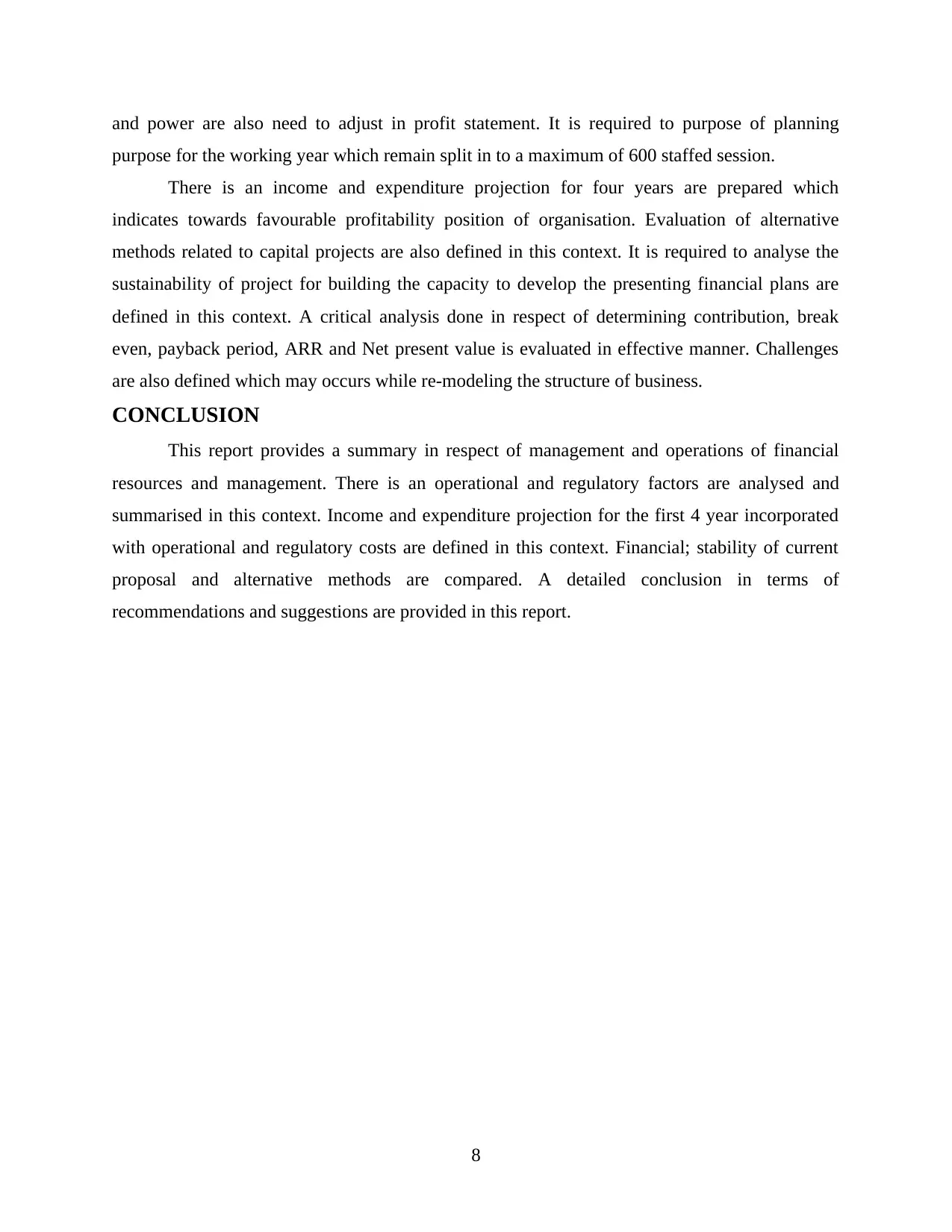
and power are also need to adjust in profit statement. It is required to purpose of planning
purpose for the working year which remain split in to a maximum of 600 staffed session.
There is an income and expenditure projection for four years are prepared which
indicates towards favourable profitability position of organisation. Evaluation of alternative
methods related to capital projects are also defined in this context. It is required to analyse the
sustainability of project for building the capacity to develop the presenting financial plans are
defined in this context. A critical analysis done in respect of determining contribution, break
even, payback period, ARR and Net present value is evaluated in effective manner. Challenges
are also defined which may occurs while re-modeling the structure of business.
CONCLUSION
This report provides a summary in respect of management and operations of financial
resources and management. There is an operational and regulatory factors are analysed and
summarised in this context. Income and expenditure projection for the first 4 year incorporated
with operational and regulatory costs are defined in this context. Financial; stability of current
proposal and alternative methods are compared. A detailed conclusion in terms of
recommendations and suggestions are provided in this report.
8
purpose for the working year which remain split in to a maximum of 600 staffed session.
There is an income and expenditure projection for four years are prepared which
indicates towards favourable profitability position of organisation. Evaluation of alternative
methods related to capital projects are also defined in this context. It is required to analyse the
sustainability of project for building the capacity to develop the presenting financial plans are
defined in this context. A critical analysis done in respect of determining contribution, break
even, payback period, ARR and Net present value is evaluated in effective manner. Challenges
are also defined which may occurs while re-modeling the structure of business.
CONCLUSION
This report provides a summary in respect of management and operations of financial
resources and management. There is an operational and regulatory factors are analysed and
summarised in this context. Income and expenditure projection for the first 4 year incorporated
with operational and regulatory costs are defined in this context. Financial; stability of current
proposal and alternative methods are compared. A detailed conclusion in terms of
recommendations and suggestions are provided in this report.
8
Paraphrase This Document
Need a fresh take? Get an instant paraphrase of this document with our AI Paraphraser
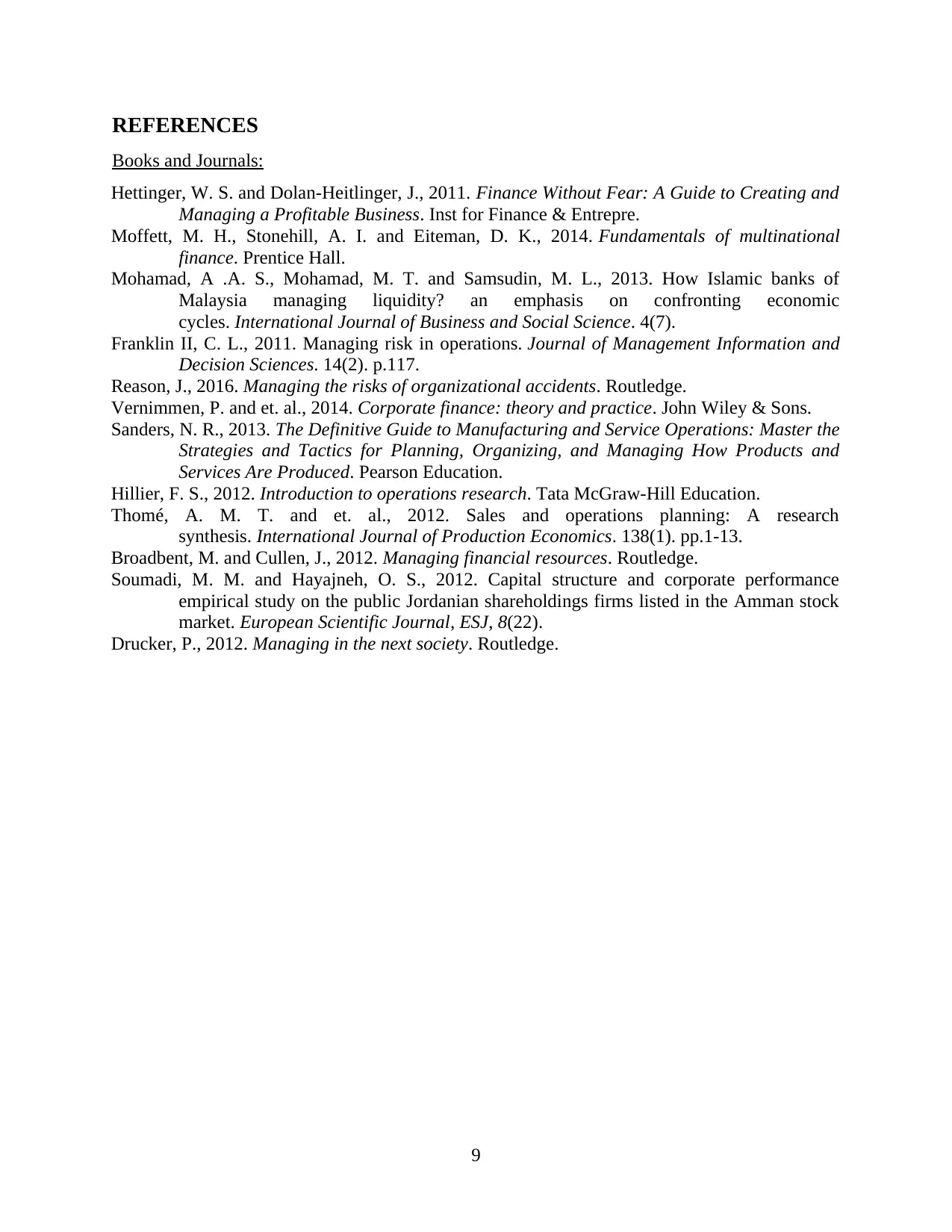
REFERENCES
Books and Journals:
Hettinger, W. S. and Dolan-Heitlinger, J., 2011. Finance Without Fear: A Guide to Creating and
Managing a Profitable Business. Inst for Finance & Entrepre.
Moffett, M. H., Stonehill, A. I. and Eiteman, D. K., 2014. Fundamentals of multinational
finance. Prentice Hall.
Mohamad, A .A. S., Mohamad, M. T. and Samsudin, M. L., 2013. How Islamic banks of
Malaysia managing liquidity? an emphasis on confronting economic
cycles. International Journal of Business and Social Science. 4(7).
Franklin II, C. L., 2011. Managing risk in operations. Journal of Management Information and
Decision Sciences. 14(2). p.117.
Reason, J., 2016. Managing the risks of organizational accidents. Routledge.
Vernimmen, P. and et. al., 2014. Corporate finance: theory and practice. John Wiley & Sons.
Sanders, N. R., 2013. The Definitive Guide to Manufacturing and Service Operations: Master the
Strategies and Tactics for Planning, Organizing, and Managing How Products and
Services Are Produced. Pearson Education.
Hillier, F. S., 2012. Introduction to operations research. Tata McGraw-Hill Education.
Thomé, A. M. T. and et. al., 2012. Sales and operations planning: A research
synthesis. International Journal of Production Economics. 138(1). pp.1-13.
Broadbent, M. and Cullen, J., 2012. Managing financial resources. Routledge.
Soumadi, M. M. and Hayajneh, O. S., 2012. Capital structure and corporate performance
empirical study on the public Jordanian shareholdings firms listed in the Amman stock
market. European Scientific Journal, ESJ, 8(22).
Drucker, P., 2012. Managing in the next society. Routledge.
9
Books and Journals:
Hettinger, W. S. and Dolan-Heitlinger, J., 2011. Finance Without Fear: A Guide to Creating and
Managing a Profitable Business. Inst for Finance & Entrepre.
Moffett, M. H., Stonehill, A. I. and Eiteman, D. K., 2014. Fundamentals of multinational
finance. Prentice Hall.
Mohamad, A .A. S., Mohamad, M. T. and Samsudin, M. L., 2013. How Islamic banks of
Malaysia managing liquidity? an emphasis on confronting economic
cycles. International Journal of Business and Social Science. 4(7).
Franklin II, C. L., 2011. Managing risk in operations. Journal of Management Information and
Decision Sciences. 14(2). p.117.
Reason, J., 2016. Managing the risks of organizational accidents. Routledge.
Vernimmen, P. and et. al., 2014. Corporate finance: theory and practice. John Wiley & Sons.
Sanders, N. R., 2013. The Definitive Guide to Manufacturing and Service Operations: Master the
Strategies and Tactics for Planning, Organizing, and Managing How Products and
Services Are Produced. Pearson Education.
Hillier, F. S., 2012. Introduction to operations research. Tata McGraw-Hill Education.
Thomé, A. M. T. and et. al., 2012. Sales and operations planning: A research
synthesis. International Journal of Production Economics. 138(1). pp.1-13.
Broadbent, M. and Cullen, J., 2012. Managing financial resources. Routledge.
Soumadi, M. M. and Hayajneh, O. S., 2012. Capital structure and corporate performance
empirical study on the public Jordanian shareholdings firms listed in the Amman stock
market. European Scientific Journal, ESJ, 8(22).
Drucker, P., 2012. Managing in the next society. Routledge.
9
1 out of 11
Related Documents
Your All-in-One AI-Powered Toolkit for Academic Success.
+13062052269
info@desklib.com
Available 24*7 on WhatsApp / Email
![[object Object]](/_next/static/media/star-bottom.7253800d.svg)
Unlock your academic potential
Copyright © 2020–2025 A2Z Services. All Rights Reserved. Developed and managed by ZUCOL.





